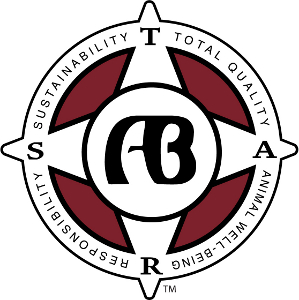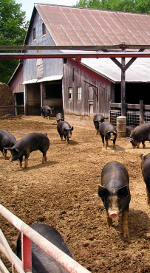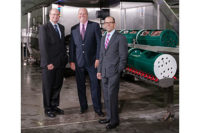Ardent believers of astrology might tell you that success in love, life and business is written in the stars. Whether destiny or fate ultimately plays a role in success or not, the world’s more proactive — and wise — companies position themselves for success wherever possible.
Take Boise, Idaho-based Agri Beef Co. for instance. No stranger to growth, this vertically integrated beef (and pork) processor aims to maintain its place as a producer of premium-quality products (not simply proteins). Robert Rebholtz Jr., president and CEO of Agri Beef, which logged $750 million in net sales in 2011 (according to information acquired for The National Provisioner’s Top 100 story in May 2012), explains that the company’s vision harkens back to that of the founder of the company — his father, Robert Sr.
 “It was always my dad’s dream to get closer to the consumer and become a food company,” he says. “My personal vision would be … continuing to keep his dream alive, and it’s encompassed in our mission statement of producing the highest-quality meat products with a commitment to superior service, value and innovation.”
“It was always my dad’s dream to get closer to the consumer and become a food company,” he says. “My personal vision would be … continuing to keep his dream alive, and it’s encompassed in our mission statement of producing the highest-quality meat products with a commitment to superior service, value and innovation.”
To foster the success of this vision, Agri Beef has spent the last decade developing premium-slanted brands, acquiring a processing facility and communicating successful initiatives that support its core values through its STAR Commitment.
Today, Agri Beef considers itself a “house of brands, rather than a branded house,” in the words of Jay Theiler, executive director, Marketing. In that “house” are four brands geared toward offering various high-quality propositions to consumers: Snake River Farms, Double R Ranch Northwest Beef, St. Helens Beef and Rancho El Oro Beef.
All beef products are produced in the company’s lone processing plant in Toppenish, Wash., which was acquired in 2003 to give the company a lot more flexibility to develop products and processes that answered the demands of its customers and consumers.
“There was a decision made to take more control of our own destiny — to get involved in the packing business,” Theiler says. “At the time, our Snake River Farms brand was really starting to gain traction domestically and internationally, and we thought it could anchor some of our future growth if we had our own facility.”
Success, and growth, came relatively quickly after the transition. To that point, Agri Beef had been heavily involved in livestock and cattle feeding operations for most of its history, but it only had the one beef brand — Snake River Farms. In the Toppenish facility deal, Agri Beef acquired the St. Helens Beef brand; Double R Ranch Northwest Beef was created in 2005; and Rancho El Oro debuted in 2008.
All these brands are driven by strict quality demands driven by the company’s core values. Theiler says, in order to avoid being viewed as another commodity beef brand, Agri Beef’s products must stand out in this way.
“Realizing that we are a small player in a very big market has kept our singular focus on producing the highest-quality meat products that we could,” he explains. Part of that high-quality proposition is the vertically integrated supply chain from which Agri Beef’s product lines originate. That system, and the communication up and down the chain, has given the brands a significant positioning boost.
“We looked at how do we breed the best genetics and then how do we get those genetics or livestock into the marketplace through our livestock division?” Theiler adds. “Then how do we feed the animals to optimal levels to insure a balance between the high quality that we want and the affordability that is necessary to make it work?”
Finally, the packing plant connects its information back on how the cattle have performed, and that information is assimilated and picked apart to drive future decisions on the production side.
“This integrated supply chain or loop actually has been a big part of helping us meet the high-quality goals that we have set for our company,” he says.
STAR Commitment
As Rebholtz explains, the mission and vision at Agri Beef Co. today isn’t much different from what it was when his father founded the company in 1968. With its roots in ranching and livestock feeding, Agri Beef’s commitment to sustainability, total quality, animal well-being and responsibility (STAR) should not surprise anyone.
Picking up pork
Hanacek: With the historical emphasis on beef, how and why did Agri Beef get into the pork business? Theiler: The pork business is a specialized niche featuring 100% Berkshire pork. We got into that business through a group of farmers that was looking for a way to stay viable. … The fact is, when we tried it, we said, “This product is tangibly different than other pork products, and it is the best that we have tried of any type of pork available in the United States.” It is Berkshire, but we decided to market it as Kurobuta, which is the Japanese word for “black hogs.” It gave us a way to reinforce the Snake River Farms brand positioning of “East meets West.” Also, it was unique, so that was a way to give more credibility to that brand. The plan is to continue to grow it, and we’re actually growing our farmer base for the hog farms currently. Hanacek: And this product line, unlike the case-ready beef line, is featured as Snake River Farms-branded product only, correct? Theiler: No other brands are [offering pork]. It’s just really unique product, and we saw it as an opportunity to build the brand by giving it a second protein. … It made our brand more efficient but also gave it the exact same positioning as the Kobe beef. It was very popular in Japan where it is considered the Kobe beef of pork. Hanacek: Is there a rough estimation as to how much you’d expect the pork business to grow? Will pork eventually be a much bigger part of the equation that it is now? Theiler: I don’t know that it will be bigger for the sake of being bigger, but we are not looking at getting in the commodity pork business, if that’s the question. It is more to continue to grow the highest-quality pork, which again ties into the mission, the highest quality beef and pork products in the segments we serve. We’re not in the commodity segment, so we’re not going to do that. But we’ve chosen to get into the ultra-premium segment, and we will continue to grow that one, in whatever proteins we process. |
Admittedly, these core values were always part of the culture, right on through the company’s transition from a producer-oriented company to a processing company. Yet, they weren’t highly visible — either internally or externally. The development of the STAR Commitment allowed Agri Beef not only to tout its values to consumers but also to imprint them upon the internal culture of the company.
“The STAR Commitment was really born from the need to make sure our employees, our customer base, our consumer base and anybody we communicate with understand what Agri Beef represents,” Theiler explains. “And it’s always part of every management meeting we have: What are we doing in each of these areas, how are we getting better?”
The STAR also gives Agri Beef pre-determined measuring guides for growth — and talking points when successful initiatives come to fruition in any particular value set. Each core value is treated equally across all divisions of the company, though initiatives and innovation tend to follow technological and process trends.
For instance, sustainability has been a hot topic throughout the beef industry for quite a while now, and Agri Beef has had its share of recent advancements in this area. According to Rick Stott, Agri Beef’s executive vice president, the University of Idaho did a study in 2009-2010 on the overall carbon footprint of Agri Beef Co. relative to the industry. Looking at Agri Beef’s supply chain, including its feedlots, the university researchers determined Agri Beef to have a carbon footprint 41 percent smaller than that of a similar operation in the Midwest.
“A lot of that has to do with the fact that we use hydro power in the Northwest,” Stott notes. “We also have a smaller footprint as far as our cattle supply sources and our customer base — we’re not trucking cattle 1,600 miles to the Midwest [for processing] and coming 2,000 miles back [to West Coast stores].”
Furthermore, Agri Beef has made tremendous upgrades to its wastewater-treatment capabilities at its Toppenish processing plant in the last three-and-a-half years. During The National Provisioner’s visit to the plant, Dave Stiner, director of facilities, explained that the wastewater-system upgrade helped reduce the plant’s bacteria count by 50 to 60 percent, and at peak efficiency, the new methane-capture system can save 17 to 19 percent of the plant’s natural-gas needs.
In terms of responsible business practices, Agri Beef has had success with its “Beef Counts” program, which was developed two-and-a-half years ago to fight hunger on a local level.
“We met with the local food bank and found out they were getting plenty of donations but nothing in high-quality protein — it was very, very rare to get anything in high-quality proteins; less than 2 percent,” Theiler recounts. “We said, ‘This is in our wheelhouse, this is what we do, we can help — this is where we can really make a difference.’”
The program was launched in Agri Beef’s home state of Idaho first, and it has since been launched in Washington as well. Agri Beef partners with the food banks to direct the product to areas of need and with local state beef councils to help promote the program. It leans on the cattle industry and the general public to donate funds for the program.
“We put up a challenge to cattle ranchers, and even consumers, to raise money for the program, and we would match that and provide the product to the food banks in family-ready packs that could be handed out through their networks,” Theiler says. The program has been very successful, providing more than 804,000 servings of beef to Northwest families in need since the program’s inception in 2010.
Agri Beef also has taken significant steps in keeping its animal-welfare measures atop their game, having collaborated with industry experts such as Temple Grandin to develop and keep up-to-date strategies in this area.
Finally, as mentioned earlier, total quality is the key driver of the operations and product-development teams. Food safety plays a significant role here as well, and the Toppenish facility has incorporated a variety of interventions to ensure a high standard of quality and food safety. According to Agri Beef, it was the first company in North America to be both ISO- and HACCP-approved throughout its entire beef supply chain, a significant achievement and now an integral part of the company’s process-oriented culture.
Reaching for the stars
With these accomplishments in the rearview mirror, Agri Beef believes it may be simply scratching the surface of its growth potential. Rebholtz knows the challenges that lie ahead.
“One thing I believe this company needs to do is grow — it’s incumbent upon myself and the family to figure out ways to continue to grow this business and allow career opportunities and growth challenges for the excellent people that are here,” he says. “So, despite the economic environment out there, we still have to look for opportunities, and when we find them, we have to take advantage of them.”
The ‘AB to Cs’ of e-commerceJay Theiler, executive director, Marketing, for Agri Beef Co., shares his insights with Andy Hanacek, editor-in-chief of The National Provisioner, on how e-commerce and strategic partnerships could help Agri Beef take another step forward. Hanacek: Agri Beef recently delved into selling its products online and through strategic partnerships with catalog-type companies. Can you explain the basics of why Agri Beef went this route? Theiler: Our e-commerce business, the direct-to-consumer is a new venture, and it’s called “AB to C”, or “Agri Beef” to “Consumer.” It’s available on two sites: www.SnakeRiverFarms.com and www.TheDoubleRRanch.com right now, and we are investing significant resources in that to grow it. It’s a business that could be much bigger in the future. We just started it about a year-and-a-half ago, and we are already seeing very solid growth and customer loyalty. Hanacek: So, it’s still in its infancy, then — what are the next steps? Marketing and promotion? Theiler: Yes, but also finding a customer base that appreciates the quality and continuing to market it to those consumers. Hanacek: You’ve got your strategy for differentiating the product in “standard” segments, but how do you make your product visible in this segment, particularly when there’s quite a few processors who do the e-commerce and catalog business and have some brand equity in those areas? Theiler: We know we can’t be Omaha Steaks, but what we can do is offer the quality that comes from our production system, and we can bend over backward to service our customers — not that those [processors] don’t do those things. But if we can do it right, we still can build a loyal customer base. I think the other part is making strategic alliances with other brands that live under similar “premium” halos as our brands. So if they have an e-commerce arm, it’s [a partnership] to reach those similar-minded consumers. For example, we do a significant amount of business as a supplier to Williams-Sonoma, and we would like to see that relationship continue to grow. Hanacek: So consumers can go on the Williams-Sonoma Web site and order your beef there? Theiler: The three sites — www.SnakeRiverFarms.com; www.TheDoubleRRanch.com and www.Williams-Sonoma.com — complement each other with different products for different customers, [and our product also] is featured in their catalogs. Williams-Sonoma is a great partner with an amazingly loyal consumer base, and we are very glad to be one of their key protein suppliers. |
Moving forward, with the assumption that the economic picture doesn’t worsen, Rebholtz believes Agri Beef could dial up its aggressiveness, as opposed to being more conservative.
“Growth will definitely be in our future,” he explains. “Short term, we’re investing in a new grinding operation (co-located within our packing facility), which will be a first for our company,and will help expand our product offering to our customers.
“I would envision potentially another processing plant, or some kind of joint venture down the road, maybe of the further-processing, value-added sort, to expand the top line,” Rebholtz adds, saying such a move likely would be three to five years away or more.
During The National Provisioner’s visit in the fall of 2012, the aforementioned grinding operation was being installed with an expected launch date of this month (January 2013) for the first chubs and patties to roll off the lines. Jason Baker, director, Value-Added Products, also shared plans for expansion of the facility’s value-added processing room and the addition of a new cooler at the plant.
Expansion of the value-added room became necessary to handle the growth of the extensive case-ready line of beef items that was launched in the first half of 2012. When they debuted, the branded lines carried eight different steak cuts and a standing rib roast, each individually packaged to meet consumer needs.
“It really comes from the fundamental trends that are happening with the consumer, who is looking at smaller portion sizes and more convenience,” Theiler explains. “The benefit for the customer is, it’s pre-packaged and ready to go — it eliminates a lot of the shrink some retailers deal with too, so it’s a win-win: We’re meeting a consumer need and a customer need, and that helps us evolve our business out of purely boxed beef.”
Theiler adds that Agri Beef hasn’t yet tapped all the potential for the line, and next on the docket could be additional marinades and flavor extensions.
“It can always evolve and be updated as trends change,” he says. “For instance, we see a lot more interest in ethnic flavors, so we’re looking at Asian-style cuts and flavors, or Hispanic-style flavors.”
Ultimately, because the line is predicated on strong consumer fundamentals, Theiler believes it will remain successful. Furthermore, as consumers’ cooking abilities have changed, this line is expected to become more important to the marketplace.
“Unfortunately, a great number of consumers have lost an understanding of the various beef cuts and how they should be prepared for an optimal eating experience, and our industry hasn’t done a particularly good job of communicating or adapting to their changing needs,” Theiler says. “We want to be able to have case-ready, convenience-oriented items that taste great, are very easy to prepare, and are perfectly cut and ready to use for a particular cooking application. That’s our goal.”
Expanding its capabilities in the value-added space is just one way in which Agri Beef has been building out the Rebholtz family’s vision for the company. How ever successful the company has been thus far — even with heavy economic pressures around it — Rebholtz knows the road ahead won’t necessarily be smooth.
“It’s going to take a lot of dedication and focus on delivering the sort of value-added products that will be accepted by the marketplace, particularly at a certain price point,” he says. “This will be a journey, and it’ll be a long journey.
“However, I think as long as we’re listening to consumers and paying close attention to what kind of products make sense from a profitability standpoint across all segments, [we have] a promising future.”








 Although the product mix at Agri Beef Co. tilts the scale heavily toward the beef side, the company views its pork business as another growth opportunity, held to the same standards as the beef business. Jay Theiler, executive director, Marketing, for Agri Beef, and Andy Hanacek, editor-in-chief of The National Provisioner, discuss the line.
Although the product mix at Agri Beef Co. tilts the scale heavily toward the beef side, the company views its pork business as another growth opportunity, held to the same standards as the beef business. Jay Theiler, executive director, Marketing, for Agri Beef, and Andy Hanacek, editor-in-chief of The National Provisioner, discuss the line.


Report Abusive Comment